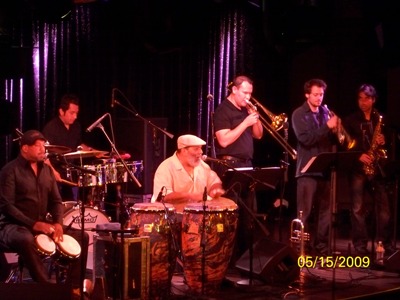|


© tt eiland, 2009 |
Jazz |
Jazz is considered the quintessential truly American music form. It is one of the three main roots of American popular music. ROOTS
Jazz's roots are American blues, African rhythms, Caribbean rhythms and melodies, and European scales. Although music that originates in the oral tradition can be hard to trace back to its inception, jazz is considered to have been started in the late 19th/early 20th century by African Americans playing in New Orleans, where European, African, Caribbean and American traditions mixed and intermingled. New Orleans was the established center of jazz by 1910. Jellyroll Morton was writing Ragtime jazz as early as 1902, and some date jazz arrangements as early as 1895. Unlike blues and folk, which tend to reflect a less educated origin, jazz was developed by highly skilled players who could take a traditional music source, such as marches, waltzes, polkas and spirituals, and alter the rhythm and change the length of time signatures to create a SWING feel that exemplifies jazz. Jazz is often claimed by various groups, but the music was played and influenced by whites and blacks and Latinos from its inception, each giving it a distinct feel, which was subsequently borrowed and incorporated by others. Men dominated early jazz, writing almost all of it and performing most. Women singers were common, but women composers and musicians were rare. LYRICAL THEMES
Much of jazz is purely instrumental; the idea is to play the tune and then play with the tune, improvising the melody. Jazz is a LIVE music, open to interpretation and change. Lyrically, the themes tend to reflect jazz's roots in the Jazz Age: partying, sorrow, and sex. Like the instrumentalists, vocalists tend to improvize, creating lyrics or even scatting, using the voice like a wind instrument, a style exemplified by Ella Fitzgerald. WHAT TO LISTEN FOR
Syncopated rhythm and a sense of swing create a fluid, performance-based music. Instrumentally, guitar and piano may be included in a lineup that traditionally incorporated brass (tuba) trombone, trumpet, alto horn, bass, and snare drum. As jazz styles evolved, electronic instruments were also highlighted. A jazz band may be as few as three (bass; piano, horn or guitar; and drum) or as many as 40 in a large big-band jazz orchestra. 4 BIG NAMES
Louis Armstrong, Antonio Carlos Jobim, George Gershwin, Jellyroll Morton Works Cited
Tucker, Mark. Jazz. New Grove Dictionary of Music and Musicians, 2nd ed.
S. Sadie and J. Tyrrell. London: Macmillan, 2001.
© T. T. Eiland, January 1998
Last modified: January 12, 2003
|
